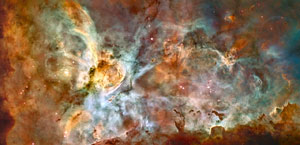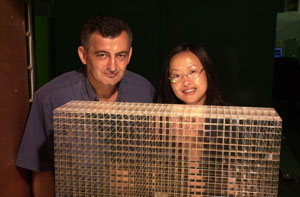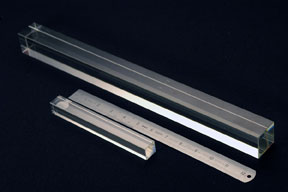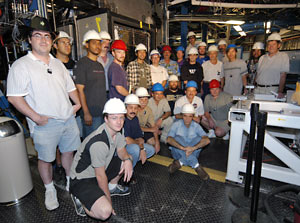2007 News Release
Studying the Universe Through Pions

This Hubble image shows the Carina Nebula, a star nursery. Image Credit: NASA, ESA, N. Smith (University of California, Berkeley), and The Hubble Heritage Team (STScI/AURA)
Pions are some of matter’s simplest particles. They’re built from the same building blocks as protons and neutrons, smaller particles known as quarks. While a proton is made from three quarks, only two quarks are needed to make a pion. In fact, the pion is the simplest particle built of quarks. The quarks are “glued” together by the strong force – a fundamental force of nature that also binds quarks to form protons and neutrons. Studying the simple pion and its properties can reveal information about matter in the universe, where it came from and how it’s held together.
To study pions, scientists are using a trick that’s equivalent to turning back time. Henry Primakoff proposed the idea in 1951. It was known that the neutral pion was a short-lived particle, lasting just billionths of a billionth of a second after its formation before falling apart. When it falls apart, or decays, usually all that remains are two particles of light, or photons.

Ashot Gasparian and Liping Gan, assistant professor of physics at the University of North Carolina at Wilmington, presented the preliminary PrimEx result at the APS April Meeting in Jacksonville.
Primakoff predicted that since the pion decays into two photons, it could also be generated from two photons. In essence, he thought that if you start with a pion, watch it decay into two photons and then reverse time – the two photons would come back together, re-building the pion. If that works, then any time you bang two photons together, there should be a chance of making a pion. When an incident photon fuses with a virtual photon from the nucleus to form a new particle (a pion in this case), the process is known as the Primakoff Effect.
Pions don’t last very long, so measuring them directly is difficult. Jefferson Lab researchers can measure pions indirectly, however, by recording the energies and positions of the decay photons. To do this, they built a novel detector called HYCAL. HYCAL allowed physicists to measure the lifetime of one type of pion, the neutral pion, at about 82 attoseconds, or 82 billion-billionths of a second.

The detector HYCAL was built with an array of lead-tungsten (bottom) and glass crystals (top). HYCAL was designed and built in just over three years, weighed in at about six tons and required nearly a million dollars to construct.
“This is the most precise measurement to date of the [neutral] pion lifetime,” says Ashot Gasparian, co-spokesman for Jefferson Lab’s Primakoff Experiment (PrimEx) and an associate professor of physics at North Carolina A&T State University. “The lifetime measurement agrees with the averaged value from previous measurements, but it is two-and-a-half times more precise.”
The preliminary result came from just one portion of the experiment; the full result is still under analysis. The PrimEx collaboration expects to be able to refine the accuracy of the measurement to a figure that's about five times more precise than the currently quoted world value.
In addition, the PrimEx collaboration plans to continue the experiment at Jefferson Lab following the proposed 12 GeV Upgrade of experimental facilities. The second stage of the experiment will attempt to measure the lifetime of other neutral particles known as eta and eta-prime. These measurements will provide fundamental input to physics, such as the mass ratio of light quarks.
This experiment was supported by the DOE Office of Science Nuclear Physics program, together with NSF programs in Major Research Instrumentation, Physics Frontiers Centers and Nuclear Physics.
More information:
Jefferson Lab Experiment Pins Down Pion
New high precision experiment for Jefferson Lab
Big Experimental Equipment: Hall B's PrimEx
Thomas Jefferson National Accelerator Facility’s (Jefferson Lab’s) basic mission is to provide forefront scientific facilities, opportunities and leadership essential for discovering the fundamental structure of nuclear matter; to partner in industry to apply its advanced technology; and to serve the nation and its communities through education and public outreach. Jefferson Lab, located at 12000 Jefferson Avenue, is a Department of Energy Office of Science research facility managed by the Jefferson Science Associates, LLC.


